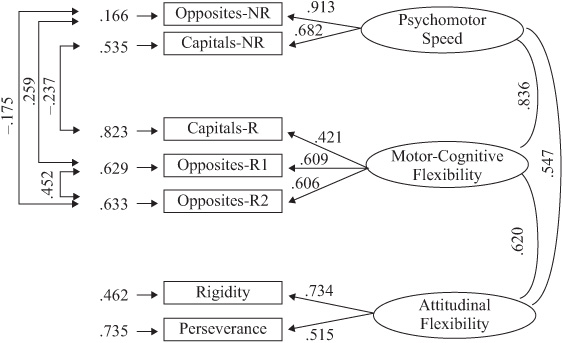
The base study that led to the Seattle Longitudinal Study (SLS; Schaie, 1958a) had as its primary objective the test of the hypothesis that differential age changes in abilities might be related to initial status on the dimensions of flexibility-rigidity (see chapter 1). Although the viability of this proposition had to be rejected on the basis of the initial cross-sectional data, we have since returned to this question, utilizing the longitudinal database for a more appropriate set of inquiries than was possible with the original 1956 data (see Schaie, 1958c). Before returning to a further examination of this issue, it is necessary first to determine whether our ability measures and the flexibility-rigidity factors defined by the Test of Behavioral Rigidity (TBR) do indeed represent independent constructs. After confirming this important assumption, we can then turn to the effect of flexible behavior at earlier ages in predicting maintenance of cognitive functioning in old age.
The original multiple group factor analyses that led to the development of the TBR (Schaie, 1955; see also chapter 4) identified the independence of three latent constructs to account for the individual differences variance in the flexibility-rigidity measures. These measures were then correlated with the five primary mental abilities in our core battery, and, given the moderate positive correlations between the flexibility-rigidity factor scores and the cognitive measures, we assumed that their independence had been empirically demonstrated (Schaie, 1958c). Given the state of the art at the time of these studies, this assumption seemed reasonable. However, modern research practice requires more formal tests. The results of such formal tests were reported by Schaie, Dutta, and Willis (1991; see also Dutta, 1992) and are summarized here.
The TBR factor structure was reexamined using the data on 1,628 participants (743 men and 885 women) who were examined in the fifth (1984) SLS cycle. The initial model tested was based on the original factor analyses (Schaie, 1955) and was examined using the LISREL procedure (for a description of the TBR subtests, see section on measurement variables in chapter 3). Seven measures were modeled to map on three cognitive style factors: Psychomotor Speed, Motor-Cognitive Flexibility, and Attitudinal Flexibility. Several of the TBR measures represent scores derived from the same subtests; hence, their errors would be expected to correlate. For example, the Capitals test yields a speed score (Cap-NR) and a flexibility score (Cap-R). Similarly, two flexibility scores are derived from the opposites test using different scoring approaches. The four elements in the error matrix corresponding to the correlation among the measures originating from the same source data were freed. The model was first tested on a random half of the total sample and then confirmed on the second random half as well as on the total sample. This model was accepted as having an excellent fit [χ2(7, N = 1628) = 14.47, p < .04; GFI = .997, RMSR = 1.64]. The measurement model for the flexibility-rigidity domain can be found in figure 9.1.
In a similar manner, we also confirmed the factor structure for our expanded battery on the same sample used for the TBR analysis. Here, the initial model was based on prior analyses, but with the addition of a Memory factor (see Schaie, Willis, Hertzog, & Schulenberg, 1987; Schaie, Willis, Jay, & Chipuer, 1989; also see chapter 8). The 20 cognitive measures were modeled as indicators of six oblique factors: Inductive Reasoning, Spatial Orientation, Verbal Ability, Numeric Ability, Perceptual Speed, and Verbal Memory. The original model had good overall fit, but for this particular sample it showed stress in the specification of the Word Fluency measure. In addition to its placement on the Memory factor, this measure was therefore allowed to load as well on the Perceptual Speed and Verbal Comprehension factors. The model was again tested on a random half of the sample, confirmed on the second half, and then reestimated on the total sample [χ2(151, N = 1628) = 1144.26, p < .001; GFI = .934, RMSR = 4.09)]. The accepted model was characterized by high and statistically significant loadings of all variables on their associated primary ability factors, as well as high communalities (see figure 9.2 for the resulting measurement model.)

FIGURE 9.1. Measurement model for the Test of Behavioral Rigidity.
The viability of the hypothesis of distinct cognitive and cognitive style domains was tested by analyzing the combined covariance matrix of the 27 cognitive and flexibility-rigidity measures. An exploratory factor analysis of this matrix suggested that from 8 to 10 factors would be required to explain the total reliable variance. Hence, our first model hypothesized the 9 factors resulting from the separate domain analyses. This model essentially specifies maintenance of the original factor structures when the two batteries are combined. We again estimated this model on a random half, with subsequent confirmation on the second half. The initial estimate suggested a good fit, with comparable parameter estimates to the separate analyses. The initial indices of model fit were χ2(280, N = 814) = 979.33, p < .001; GFI = .918; RMSR = 5.1, for Sample 1, and X2(280, N = 814) = 1095.73, p < .001; GFI = .909; RMSR = 5.66 for Sample 2.
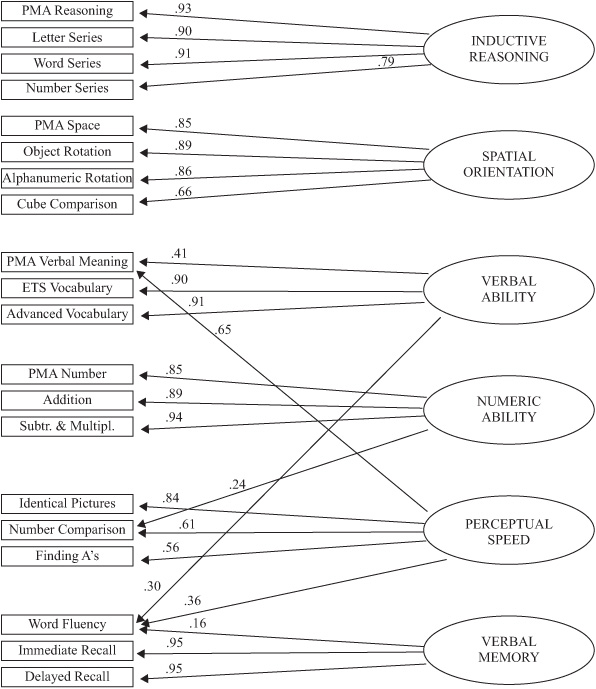
FIGURE 9.2. Measurement model for the expanded cognitive ability battery. ETS, Educational Testing Service; PMA, Primary Mental Abilities.
Cross-battery interfactor correlations were then examined, and three high correlations were identified. The Psychomotor Speed and Motor-Cognitive Flexibility factors correlated highly with inductive reasoning, and Perceptual Speed correlated highly with Psychomotor Speed. As our exploratory analyses had suggested the plausibility of an eight-factor solution, and because the highest interfactor correlations were found between the two speed factors, we next examined a model combining them into a single factor. However, this model resulted in a significantly worse fit [Δχ2(8, N = 814) = 137.29, p < .01 in Sample 1, and ΔX2(8, N = 814) = 121.41, p < .01 in Sample 2] and was therefore rejected. The accepted total model has a good fit [X2(280, N = 814) = 1116.62, p < .001; GFI = .924; RMSR = 5.08]; it is shown in table 9.1.
We concluded from these studies that rigidity-flexibility does indeed represent a domain of cognitive styles that can be distinguished from the cognitive abilities domain. The question of the reciprocal influence of these two domains first raised at the inception of the SLS (Schaie, 1958c) therefore continues to be of interest and is examined below.
To answer whether rigidity-flexibility affects the maintenance of intellectual abilities into old age, the concurrent relationship between rigidity-flexibility and core ability measures is examined first. Then, the cross-lagged correlations between the two domains are examined to generate hypotheses about the possible causal path between the domains. These relationships were originally examined for the first four study cycles (Schaie, 1983a, 1984b). Data presented in this chapter, however, include all seven cycles.
To obtain the largest possible sample sizes, we aggregated all subjects at first test for the measures in the core battery. Table 9.2 lists correlations for all available ages. It should be noted that there are moderate-to-substantial correlations between Psychomotor Speed and all ability measures. This correlation is highest with Verbal Meaning, Reasoning, and Word Fluency. Motor-Cognitive Flexibility also correlates moderately with all ability measures, with the highest relationship found with Verbal Meaning and Reasoning. Somewhat lower correlations, mostly during midlife, are found between Attitudinal Flexibility and Verbal Meaning, Reasoning, and Word Fluency. Of considerable interest is the finding that, for all three correlates, values of the concurrent correlations typically increase from young adulthood to late midlife but decline somewhat thereafter. These findings suggest that the reciprocal relationship between intellectual abilities in cognitive styles is particularly salient in midlife.
TABLE 9.1. Accepted Solution for the Combined Cognitive Styles and Cognitive Abilities
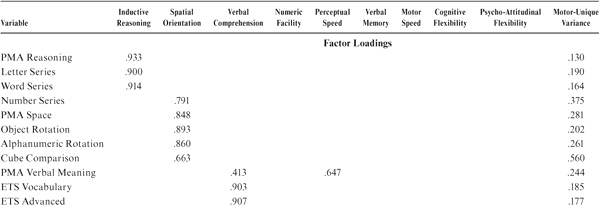

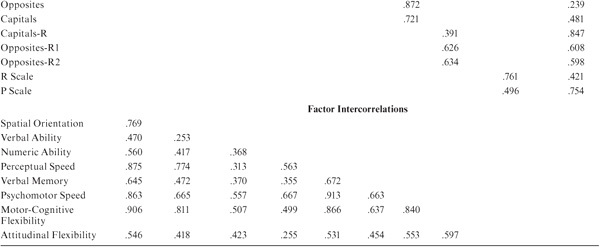
TABLE 9.2. Concurrent Correlations Between the Cognitive Style and Intellectual Ability Measures at First Test
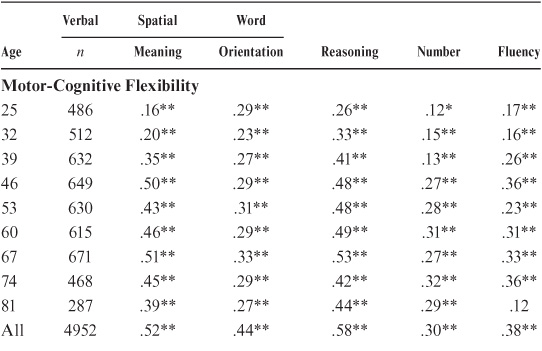
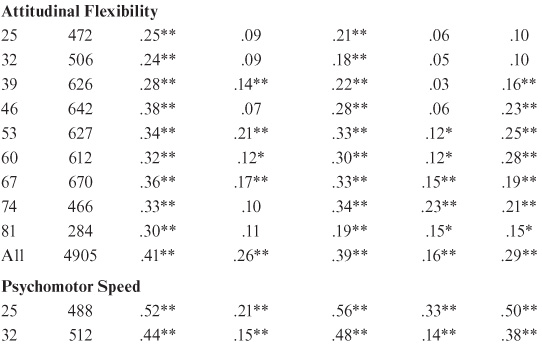
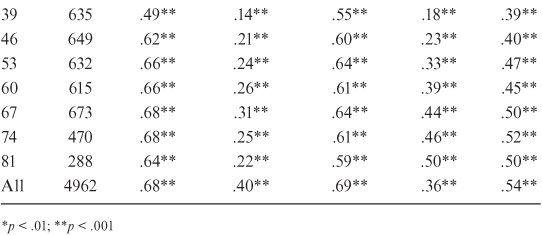
From the longitudinal data on the rigidity-flexibility and cognitive ability measures, it is possible to compute cross-lagged correlations that can be used in a cautious test of the time-dependent causal relationships between the two domains. For this purpose, we use the sample first tested in 1956 over 7-, 14-, 21-, 28-, 35-, and 42-year intervals (N = 302, 163, 130, 97, 75, and 38, respectively). Again, the measures used are the five primary mental abilities of the core battery and the three cognitive style factor scores. For each of the six time intervals, cross-lags were corrected using Kenny’s (1975, 1979) method, and significant differences between cross-lags were computed by the Pearson-Filon test. Table 9.3 shows the cross-lagged correlations for each of the six time periods.
In this sample, we find a number of predictive relationships that differ somewhat, depending on the length of time between the measurement of the predictor and criterion variables. For the 7-year interval, the causal path is from both Motor-Cognitive and Attitudinal Flexibility to the T2 measure of Verbal Meaning. However, there is also a causal path from reasoning at T1 to Psychomotor Speed at T2. These paths are not found for the 14-year interval. Instead, Motor-Cognitive Flexibility and Psychomotor Speed have causal paths to the T3 measure of the Number ability. In addition, Reasoning has causal paths to Attitudinal Flexibility and Psychomotor Speed. Over the 21-year interval, there is a causal path from Motor-Cognitive Flexibility to Word Fluency, as well as a path from Spatial Orientation to Attitudinal Flexibility to Psychomotor Speed at T4.
Significant paths are found from Spatial Orientation at T1 to Attitudinal Flexibility at T5. Also, there are significant paths from Verbal Meaning and Spatial Orientation to Psychomotor Speed. Across the 35-year interval, causal paths are found from Motor-Cognitive Flexibility to Number and Word Fluency and from Attitudinal Flexibility to Word Fluency. In addition, there is a significant path from Reasoning to Motor-Cognitive Flexibility. Finally, there are significant cross-lags over 42 years from Motor-Cognitive Flexibility to Spatial Orientation; from Attitudinal Flexibility to Number and Word Fluency; from Psychomotor Speed to Verbal Meaning, Number, and Word Fluency; and from Reasoning to Motor-Cognitive Flexibility.
One of the difficulties in interpreting these analyses is the successive attrition of the long-term sample, so that sample sizes over time become too small to obtain stable cross-lags. However, most of the causal paths clearly lead from the cognitive style measures to the intellectual abilities.
TABLE 9.3. Cross-Lagged Correlations Between the Cognitive Style and Intellectual Ability Variables
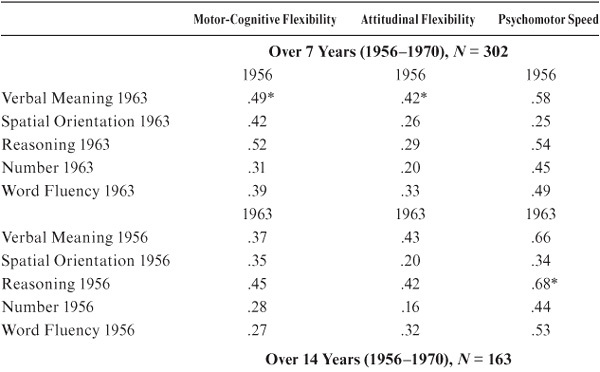
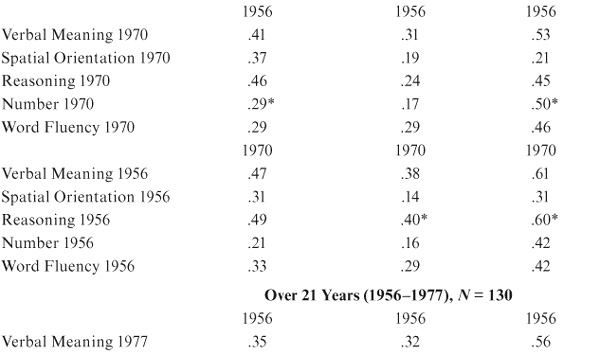
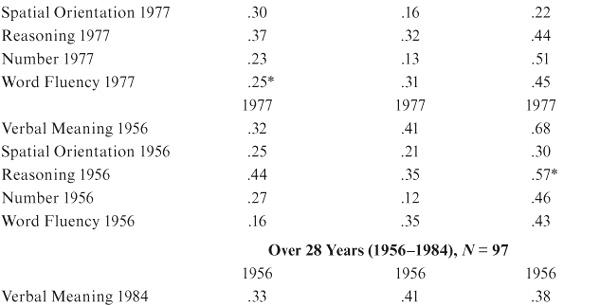
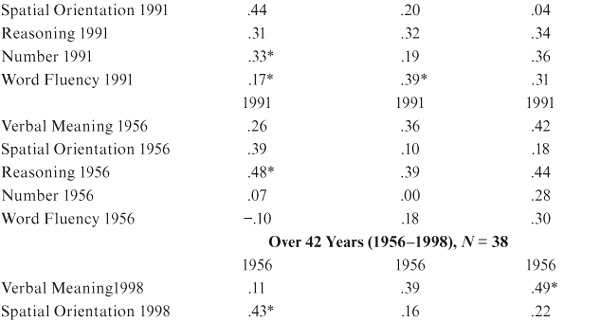
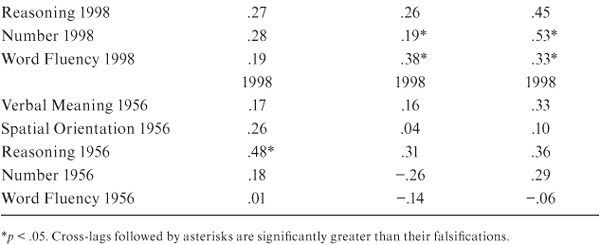
Of interest also is a repetition of these analyses for the relationship of the cognitive styles and the latent cognitive ability measures. The latter data are available only for the 1984, 1991, 1998, and 2005 cycles.
The relevant correlations are provided in table 9.4. For Motor-Cognitive Flexibility, the strongest concurrent relationships are shown with Inductive Reasoning, Perceptual Speed, and Spatial Orientation; Attitudinal Flexibility has modest correlations with all ability factors except Numeric Ability. There are substantial correlations for Psychomotor Speed with all ability factors; these are strongest for Perceptual Speed and Inductive Reasoning and weakest with Numeric and Verbal Abilities. The concurrent correlations for the factor scores follow the age pattern described in the preceding section. They are fairly weak in young adulthood and increase with advancing age.
TABLE 9.4. Concurrent Correlations Between the Cognitive Style and Intellectual Ability Latent Construct Measures
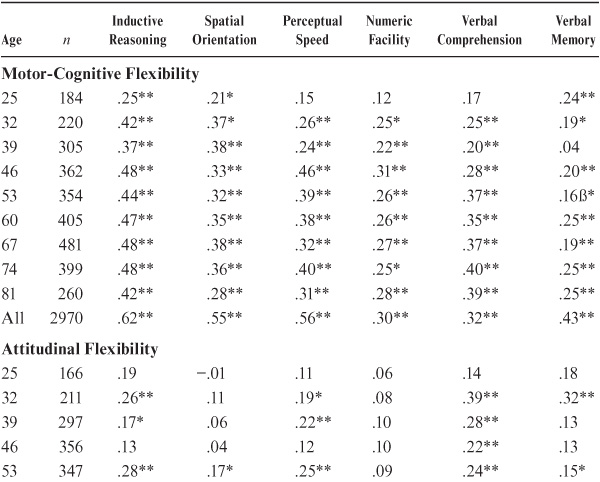
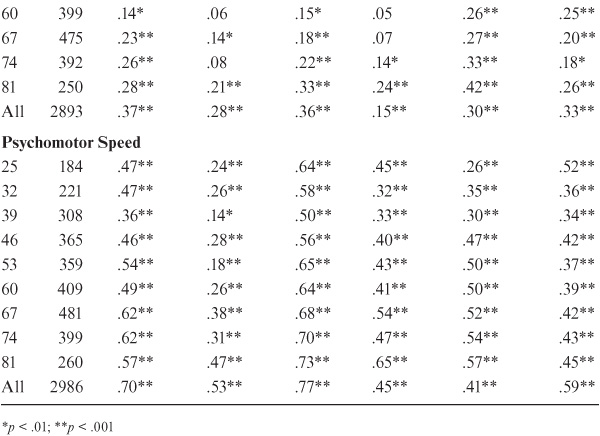
The 7- and 14-year cross-lags are available for those study participants for whom latent ability construct scores are available in 1984, 1991, and 1998 as well as the subset that was retested in 2005. These cross-lags are shown in table 9.5. Cross-lag differences significant at or beyond the 1% level of confidence occur for all three cognitive style measures from T1 to the latent construct measure of Numeric Ability in 1991. However, we also found significantly larger cross-lags from the Inductive Reasoning and Perceptual Speed factor score at T1 to Psychomotor Speed in 1991.
TABLE 9.5. Cross-Lagged Correlations Between the Cognitive Style and Intellectual Ability Latent Factor Scores
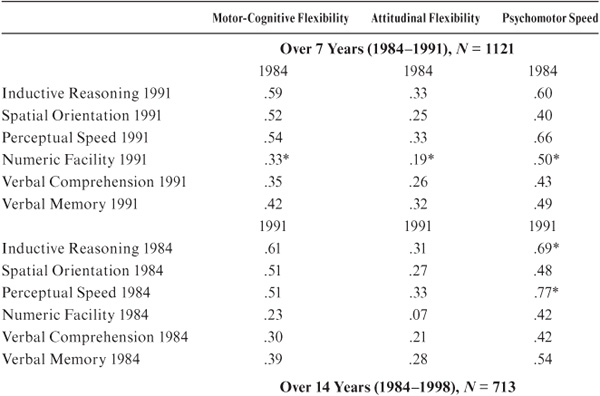
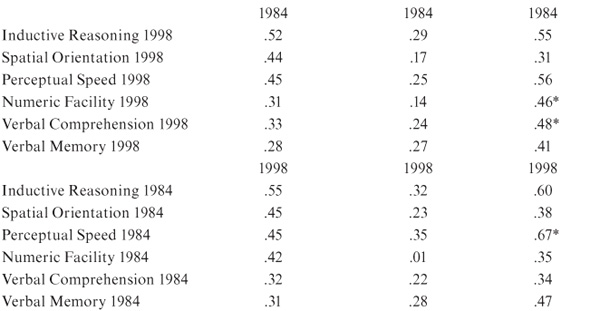
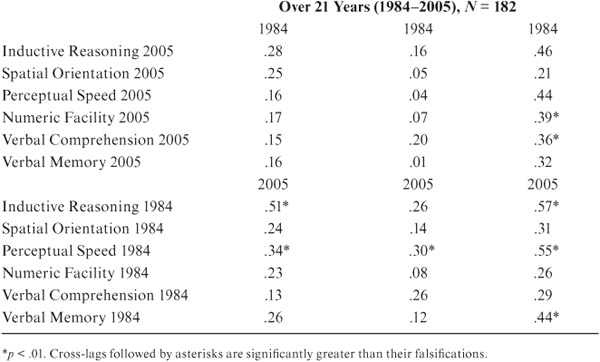
Over the 14-year period, significant cross-lags were found from Psychomotor Speed at T1 to Numeric and Verbal Ability at T3. In the opposite direction, there was a significant cross-lag from Perceptual Speed at T1 to Psychomotor Speed at T3. Over the 21-year period from 1984 to 2005, significant cross-lags were found from Psychomotor Speed at T1 to Numeric Facility and Verbal Comprehension at T4. In addition, significantly larger cross-lags were found for Inductive Reasoning at T1 to Motor-Cognitive Flexibility and Psychomotor Speed at T4, from Perceptual Speed at T1 to all measures of flexibility-rigidity at T4, and from Verbal Memory at T1 to Psychomotor Speed at T4.
In this chapter, we first present evidence on the distinctiveness of the cognitive styles of Motor-Cognitive Flexibility, Attitudinal Flexibility, and Psychomotor Speed from the domain of psychometric intelligence as measured in the SLS. Results of separate and joint factor analyses for the three cognitive styles and six psychometric ability constructs lead us to conclude that these domains are indeed separate.
We next consider the concurrent and predictive relationships for the two domains utilizing the cognitive style and core battery primary mental ability variables over 7, 14, 21, 28, 35, and 42 years. We conclude that the concurrent relationships increase into young old age and then decline again. We also examine similar data for the latent ability constructs over 7- and 14-year periods.
The predictive direction was identified to lead from the cognitive style measures to the ability measures of Verbal Meaning, Number, and Word Fluency in the core battery and to the latent construct measures of Verbal and Numeric Ability. However, there are inconsistencies over different time intervals, and occasional paths in the core battery from Verbal Meaning to Psychomotor Speed and from Reasoning to Motor-Cognitive Flexibility are found.
For the latent constructs, causal paths are identified from the measures of cognitive style to Numeric Ability over 7, 14, and 21 years and from Psychomotor Speed to Verbal Ability over 14 years. However, there are also significant cross-lags from Inductive Reasoning and Perceptual Speed to Psychomotor Speed.